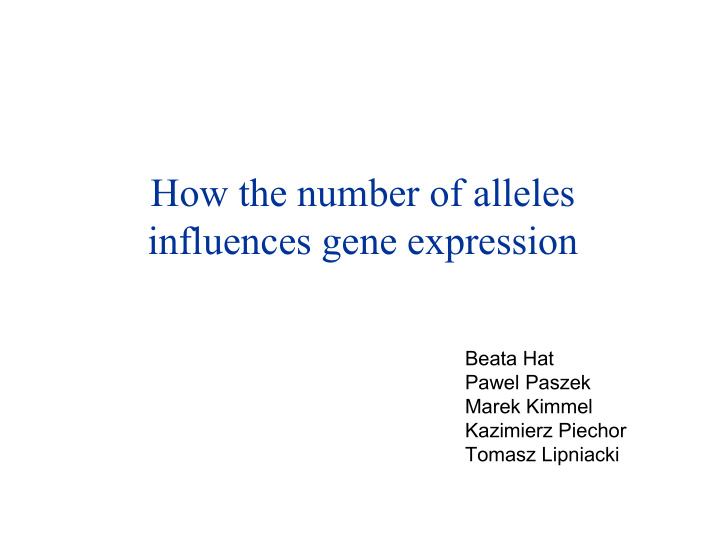



How the number of alleles influences gene expression Beata Hat Pawel Paszek Marek Kimmel Kazimierz Piechor Tomasz Lipniacki
2/15 Single cell experiments Cytoplasm - nucleus oscillations in NF-kB (red) and IkBa (green) system after TNF treatment Immortal cancer cell line (SK-N-AS cells), M.R.H. White group IL8 mRNA level after TNF treatment Immortal cancer cell line (HeLa cells), A. Brasier group
3/15 The main steps in gene expression b The number of molecules involved:
4/15 The aim of this work • How increase in number of gene alleles due to the cancer development or genome duplication in a cell cycle influences its regulation • How the loss of one allele or its transcriptional inactivity can result in haploinsufficiency disease for autoregulated genes • To deduce the behavior of „normal” cells from experiments on the transfected cells
5/15 A single haploidal gene without feedback regulation G - gene state H - transcription rate K - translation rate r - protein degradation rate Continuous approximation # of mRNA molecules # of protein molecules
6/15 Probability density functions The continuity equations for f ( x , y , t ) and g ( x , y , t )
7/15 Haploidal gene with feedback • The protein degradation time is much larger than mRNA one (the protein is synthetized directly from the gene and regulates its own expression) y ( t ) - protein level We have the following continuity equations for f ( y,t ) and g ( y ,t ) For we obtain
8/15 Diploidal gene with feedback In the case without feedback ( and ) the functions are given by the convolution formulas where and for and for
9/15 Positive Feedback We consider the external induction of self-activating gene There are three patterns of N - allelic ( N = 1, 2, 4) gene activation corresponding to different pairs of and in - plane {A} - mode in which gene remains Active haplo (i.e. ) for all {B} - mode in which gene activates for some and distribution is transiently Bimodal diplo {U} - mode in which gene activates for some and its distribution remains Unimodal tetra
10/15 3 modes of diploidal gene activation Protein distributions {A} - mode {B} - mode Mean and variance (per gene copy) {U} - mode
11/15 haploidal gene 3 regions in - plane corresponding to 3 modes of activation diploidal tetraploidal
9 possible patterns of 1-,2- and 4-copy-gene-system activation haplo diplo tetra {ABU} sector denotes that tetraploidal gene is in the {A}-mode, diploidal - in the {B}-mode, haploidal - in the {U}-mode
13/15 Mode {AAB}, Protein distributions Mean and variance of the protein (per gene copy)
14/15 Mode {ABU}, Protein distributions Mean and variance of the protein (per gene copy)
Take Home Conclusions Considering the simultaneous activation of a haploid, diploid and tetraploid gene there exist nine modes of gene activation - allele loss may stop the persistent gene activity and lead to disease if the constant level of gene product is required - gene duplication may result in a persistent activity and lead to disease when haploid or diploid gene is „designed” to act as a switch
Recommend
More recommend